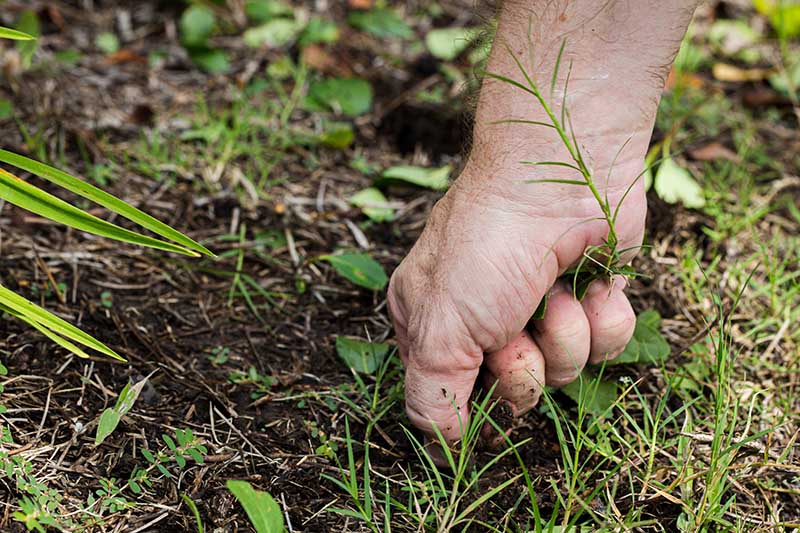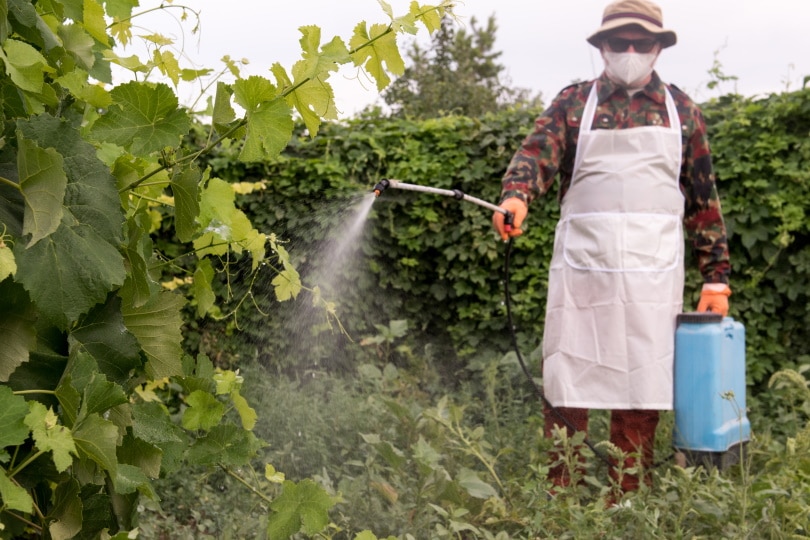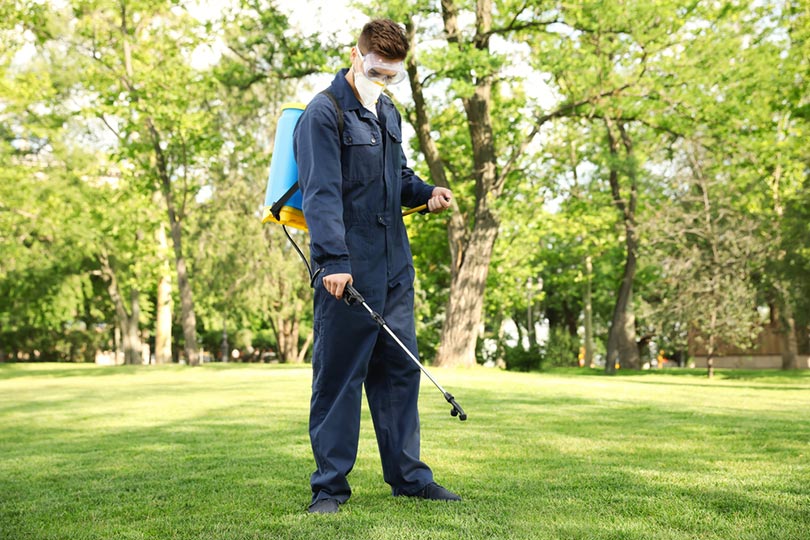How to Get Rid of Chiggers in Your Yard: 7 Simple Tips
-
Pete Ortiz
- Last updated:

Some people think that chiggers are a myth because they are nearly microscopic. But anyone who has suffered a rash of chigger bites can tell you that these pests do indeed exist. Chiggers are tiny mites that infest lawns across the United States and Europe. They can cause extremely itchy bites and skin irritation, so it is best to avoid areas where chiggers are common. If you think you have chiggers hiding in your yard, you should move to eliminate them to avoid any unpleasant irritation.
Here are seven tips on how to get rid of chiggers in your yard, including the best options, common myths, and ways to tell if you have a true infestation. But first…
 What Are Chiggers?
What Are Chiggers?
Chiggers are a specific species of mite called Trombiculidae. Mites are extremely small arachnids that are frequently irritants to humans. They are parasitic and extremely difficult to see. Most mites are so small you can barely see them with the naked eye. Chiggers are also tiny, but they can be easier to see than other mites because they are bright red.
Chigger is the colloquial term most commonly used in the United States, especially in the south. In Europe, chiggers are known as harvest mites. Sometimes they are called berry bugs due to their bright red color.
The 7 Ways to Get Rid of Chiggers From Your Yard
1. Mow Your Lawn
One of the easiest things you can do to help get rid of chiggers in your yard is to mow your lawn frequently. Chiggers like to cling to tall grass and keeping your grass short will remove their habitat and scatter any existing chiggers. The longer your grass is, and the longer you wait between mowing, the more likely you are to attract chiggers to your yard. Without tall grass, chiggers will have nowhere to live, and they will be forced to move on to better habitats.

2. Pull Up Weeds and Brush
Similar to mowing your lawn, you should also strive to pull up large weeds and brush. Sometimes weeds and brush escape mowing because they are near fence lines or at the base of trees. You should use a weed whacker, pruner, shears, or gloves to cut and pull out any weeds that might be growing in your yard. If you mow your lawn but leave weeds and brush around the edges, there is a good chance the chiggers will just move to those areas instead of living in the grass itself.
3. Drive Away Common Carriers
Just like chiggers can hitch a ride on human skin, they also travel on the backs of other animals. One of the ways to reduce the prevalence of chiggers and decrease your risk of a new infestation is to keep your yard free of other animals. The most common animals to carry chiggers include rodents like squirrels, mice, and chipmunks. Chiggers can also hitchhike on frogs, toads, and lizards. Eliminating standing water, putting up a fence, or letting dogs or cats out into the yard can help keep these animals away and therefore keep mobile chiggers away as well.

4. Use Diatomaceous Earth
Diatomaceous earth is one of the most effective ways to kill bugs such as mites and insects. Other pesticides can struggle to penetrate bugs’ rigid exoskeletons. Diatomaceous earth cuts through the chiggers’ exoskeletons and then dehydrates them and dries them out. Simply spread powdered diatomaceous earth around problem areas and wait a couple of days. The earth will soak in and coat any chiggers leading to their quick demise. Diatomaceous earth is completely natural and safe to use, which makes it a great option for people who do not want to use harsh chemicals in their yards.
5. Use Chemical Pesticides
Chemicals are not always the most popular choice or the safest choice to use in your yard, but they are very effective. Pesticide sprays are the most effective against chiggers. Granular pesticides are also effective but less so. You want to look for pesticides that include ingredients such as bifenthrin, cyfluthrin, esfenvalerate, or permethrin. These chemicals are the most effective at reducing chigger numbers and preventing them from repopulating your yard. Make sure to read the instructions carefully before applying any pesticides to your yard. Also, look out for side effects, risks, and dangers associated with the specific pesticide that you choose.

6. Target Heavily Infested Areas
Chiggers like to congregate in concentrated areas where they swarm and create large numbers. These are the areas that you want to target the most heavily. Look for brushy areas, areas with tall grass or weeds, or areas where bites are frequent and common. You do not need to target your whole yard if the chigger population is confined to one specific area. The areas where chiggers are most common or in the highest numbers are the areas that should be targeted the heaviest.
Sometimes, this can mean using different methods. For example, you might want to sprinkle diatomaceous earth around the majority of your lawn but use a more potent chemical pesticide on the heavily infested area for the best results.
7. Call a Professional
If push comes to shove, you can always call a professional. Licensed pest control technicians will have access to knowledge and tools that you might not have at your disposal. They can use specific chemicals, treat large areas, and identify likely sources of the infestation. Calling a professional takes time and costs money, and they might suggest using chemicals in your yard that you are not comfortable with. However, they are usually very effective at eliminating chigger infestations permanently from problem areas. Chiggers can be very annoying and cause some seriously itchy bites, so getting rid of them professionally might be the best idea for some people and some properties.

Find a pest-control specialist in your area, and get free, no-commitment estimates for your project.Consult a PEST-CONTROL expert

Do Chiggers Really Live in Spanish Moss?
One of the biggest myths about chiggers is that they absolutely infest Spanish moss. Spanish moss is very common throughout the southern United States, and many people are told never to touch Spanish moss because of these bothersome mites. This myth is somewhat true. Spanish moss growing in or on trees will not have chiggers in it. Chiggers live on the ground, so if the Spanish moss is up off the ground, it is safe from chiggers. However, Spanish moss that has fallen to the ground and is left to sit in the grass for an extended period could attract chiggers.
How Can You Tell If You Have Chiggers?
Some people automatically assume that they have chiggers if they get small itchy bites that they can’t readily identify. Chiggers are an easy target to blame because they are difficult to see and supposedly inhabit nondescript brush. However, there is a way that you can tell if you actually have chiggers or not.
Take a piece of dark cardboard. Black is the best color. You can even use a small chalkboard or pieces of thick construction paper. Place these black surfaces in areas of your yard where you think that chiggers might be present. Propping them up works best. Leave the black materials out for a few hours and then go carefully check them. If you have a sizable chigger population, you should see tiny red mites scurrying around on the dark background.
You can move the black screens around to see what areas have chiggers and what areas do not. You might need to use a flashlight or a magnifying glass to see them properly because they are so small.
Conclusion
Chiggers are a serious nuisance with very little benefit to keeping them around. If you suspect you have chiggers in your yard, the best thing to do is try to get rid of them. You can do this easily by simply clearing your lawn of tall grass, weeds, and brush. You do not want to get chiggers on your skin because it is an awful experience.
Featured Image Credit: Jon Williams 9374, Shutterstock
Contents

 What Are Chiggers?
What Are Chiggers?